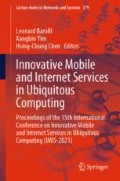Abstract
Smart home technology is evolving quickly, and numerous smart home devices associated with Artificial Intelligence (AI) have increased the quality of life for occupants. The purpose of making this tool is to design, build, and test the Internet of Things (IoT) using the Universal Board with the ATMega328 microcontroller to measure, record, and display data via a smartphone. The Sugeno fuzzy method is used to find the cryptic value of the system. The system design consists of a series of Universal Board modules with an ATMega328 microcontroller which acts as a controller for automatic drying monitoring, a series of light-dependent resistor sensors, raindrop, and DHT22 sensors, as well as a DC number and a micro switch that functions as the output of all these sensors. The data obtained is displayed on the mobile application. These tools and applications have worked well, it can be seen from the several tests that have been carried out there are no significant differences in system calculations and manual calculations.
Access this chapter
Tax calculation will be finalised at checkout
Purchases are for personal use only
References
Farid, A.M., Sharifi, J., Mouhoub, M., Barakati, S.M., Egerton, S.: Multiple objective optimizers for saving water and energy in smart house. In: IEEE International Conference on Systems, Man and Cybernetics (SMC) (2019)
García, L., Parra, L., Jimenez, J.M., Lloret, J., Lorenz, P.: IoT-based smart irrigation systems: an overview on the recent trends on sensors and IoT systems for irrigation in precision agriculture. Sensors 4(20), 1042 (2019)
Chiu, C.-H., Peng, Y.-F.: Design of Takagi-Sugeno fuzzy control scheme for real world system control. Sustainability 11(14), 3855 (2019)
Aditya, F.G., Hafidudin, H., Permana, A.G.: Analisis Dan perancangan prototype smart home dengan sistem client server berbasis platform android melalui komunikasi wireless. eProc. Eng. 2(2) (2015)
Guo, X., Shen, Z., Zhang, Y., Wu, T.: Review on the application of artificial intelligence in smart homes. Smart Cities 2(3), 402–420 (2019)
Li, S., Da Xu, L., Zhao, S.: The internet of things: a survey. Inf. Syst. Front. 2(17), 243–259 (2015)
Macioł, A., Macioł, P., Mrzygłód, B.: Prediction of forging dies wear with the modified Takagi-Sugeno fuzzy identification method. Mater. Manuf. Processes 6(35), 700–713 (2020)
Marry, W.: Disruptive civil technologies six technologies with potential impacts on us interests out to 2025 (2013)
Martin, C.L., Pasquier, J.L., Yanez, C.M., Tornes, A.: Software development effort estimation using fuzzy logic: a case study. In: Sixth Mexican International Conference on Computer Science (ENC’05) (2005)
Nassif, A.B., Capretz, L.F., Ho, D.: Estimating software effort based on use case point model using sugeno fuzzy inference system. In: IEEE 23rd International Conference on Tools with Artificial Intelligence (2011)
Putri, D.R., Perdana, D.P., Bisono, Y.G.: Design and performance analysis of smart roof clothesline system based on microcontroller by smartphone application. TEKTRIKA-Jurnal Penelitian dan Pengembangan Telekomunikasi, Kendali, Komputer, Elektrik, dan Elektronika 1(2) (2017)
Ramírez-Faz, J., Fernández-Ahumada, L.M., Fernández-Ahumada, E., López-Luque, R.: Monitoring of temperature in retail refrigerated cabinets applying IoT over open-source hardware and software. Sensors 3(20), 846 (2020)
Stojkoska, B.L.R., Trivodaliev, K.V.: A review of Internet of Things for smart home: challenges and solutions. J. Clean. Prod. 140, 1454–1464 (2017)
Tan, L., Wang, N.: Future internet: the internet of things. In: 3rd International Conference on Advanced Computer Theory and Engineering (ICACTE) (2010)
Wortmann, F., Flüchter, K.: Internet of things. Bus. Inf. Syst. Eng. 3(57), 221–224 (2015)
Wu, M., Lu, T.-J., Ling, F.-Y., Sun, J., Du, H.-Y.: Research on the architecture of Internet of Things. In: 3rd International Conference on Advanced Computer Theory and Engineering (ICACTE) (2010)
Carletti, C., et al.: Thermal and lighting effects of an external venetian blind: experimental analysis in a full scale test room. Build. Environ. 106, 45–56 (2016)
Chai, T., Draxler, R.R.: Root mean square error (RMSE) or mean absolute error (MAE)? – arguments against avoiding RMSE in the literature. Geosci. Model Dev. 7, 1247–1250 (2014)
Trillas, E., Eciolaza, L.: Fuzzy Logic, vol. 10, pp. 978. Springer International Publishing (2015). https://doi.org/10.1007/978-3-319-14203-6
Chen, H.C., Wicaksana, G., Widodo, A.M., Wisnujati, A.: The Internet of Things (IoT) for automatic control mobile based on fuzzy Sugeno method. Future ICT 2021. Taichung, Taiwan, 01–05 Feb 2021
Acknowledgements
This work was also supported in part by the Ministry of Science and Technology, Taiwan, under Grant both No. MOST 109-2221-E-468-009-MY2 and No. MOST 110-2218-E-468-001-MBK. This work was also supported in part by Ministry of Education under Grant No. I109MD040. This work was also supported in part by Asia University Hospital under Grant No. 10951020.
Author information
Authors and Affiliations
Corresponding authors
Editor information
Editors and Affiliations
Rights and permissions
Copyright information
© 2022 The Author(s), under exclusive license to Springer Nature Switzerland AG
About this paper
Cite this paper
Chen, HC., Wicaksana, G., Widodo, A.M., Wisnujati, A., Kung, TL., Lin, WY. (2022). Automatic Control System for Venetian Blind in Home Based on Fuzzy Sugeno Method. In: Barolli, L., Yim, K., Chen, HC. (eds) Innovative Mobile and Internet Services in Ubiquitous Computing. IMIS 2021. Lecture Notes in Networks and Systems, vol 279. Springer, Cham. https://doi.org/10.1007/978-3-030-79728-7_35
Download citation
DOI: https://doi.org/10.1007/978-3-030-79728-7_35
Published:
Publisher Name: Springer, Cham
Print ISBN: 978-3-030-79727-0
Online ISBN: 978-3-030-79728-7
eBook Packages: Intelligent Technologies and RoboticsIntelligent Technologies and Robotics (R0)

